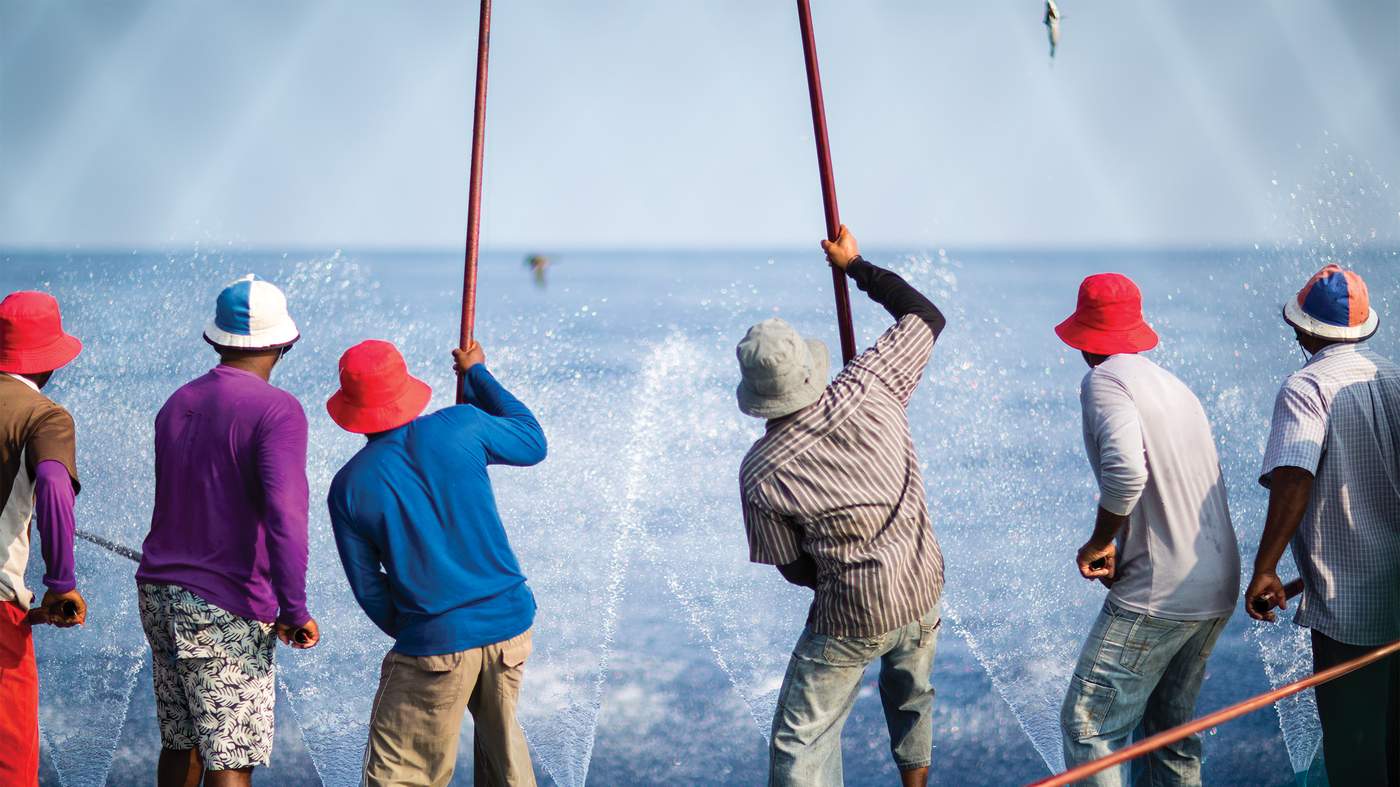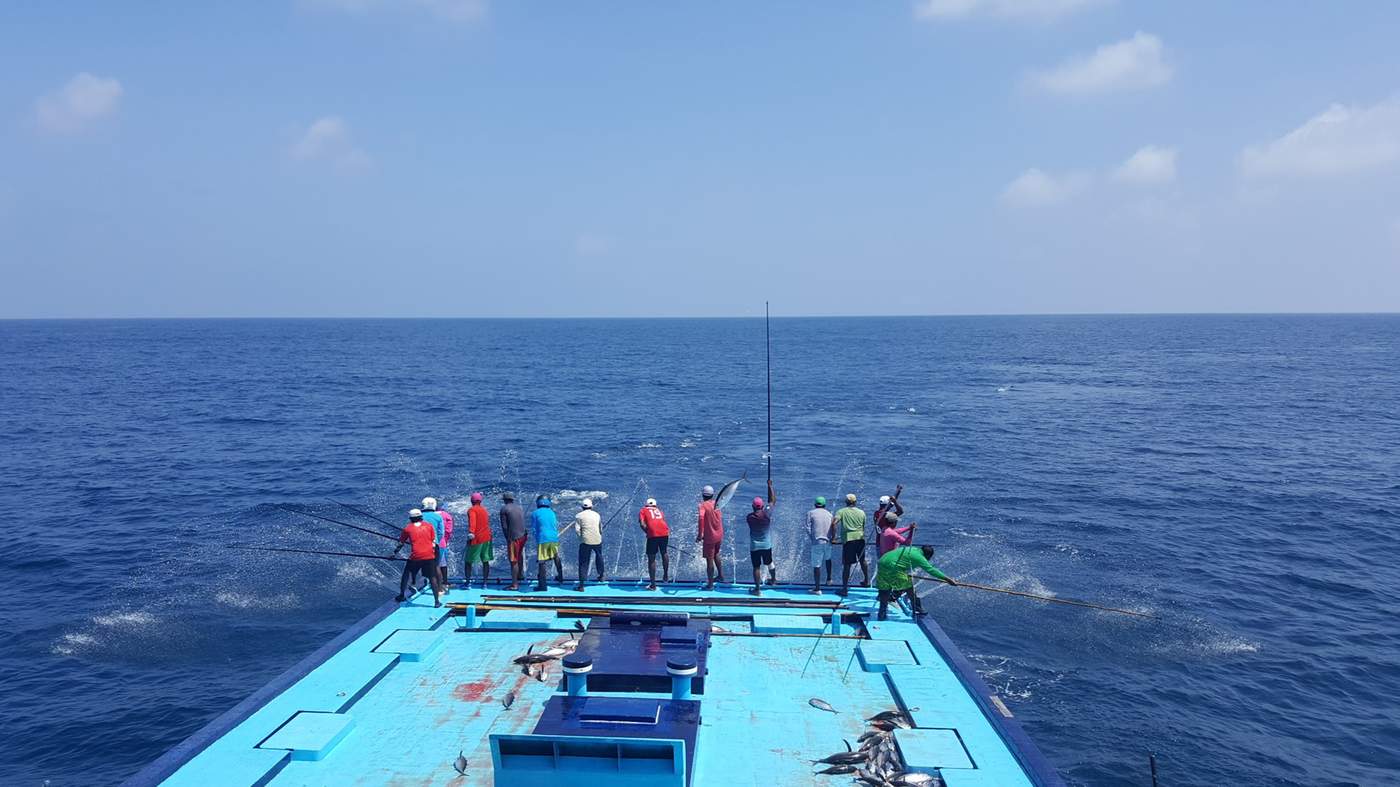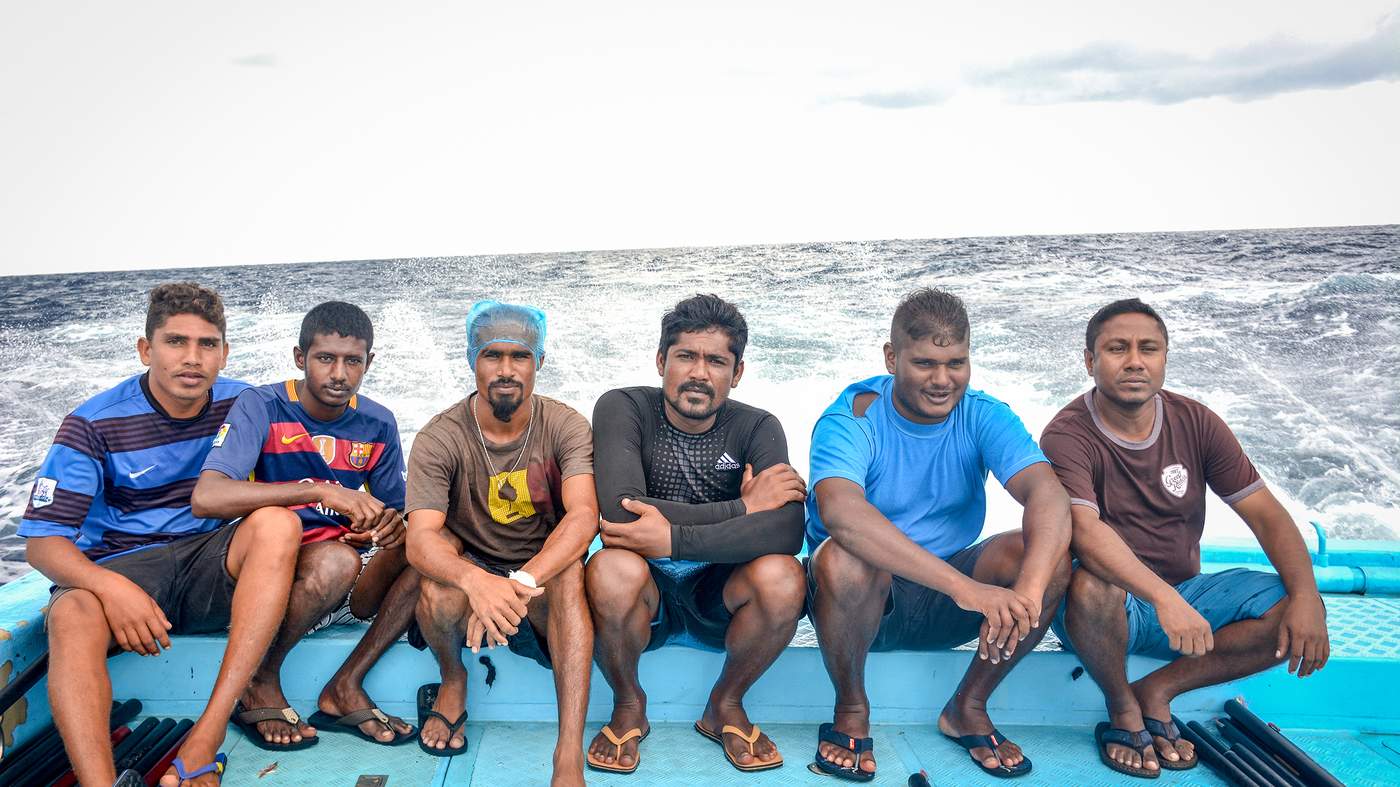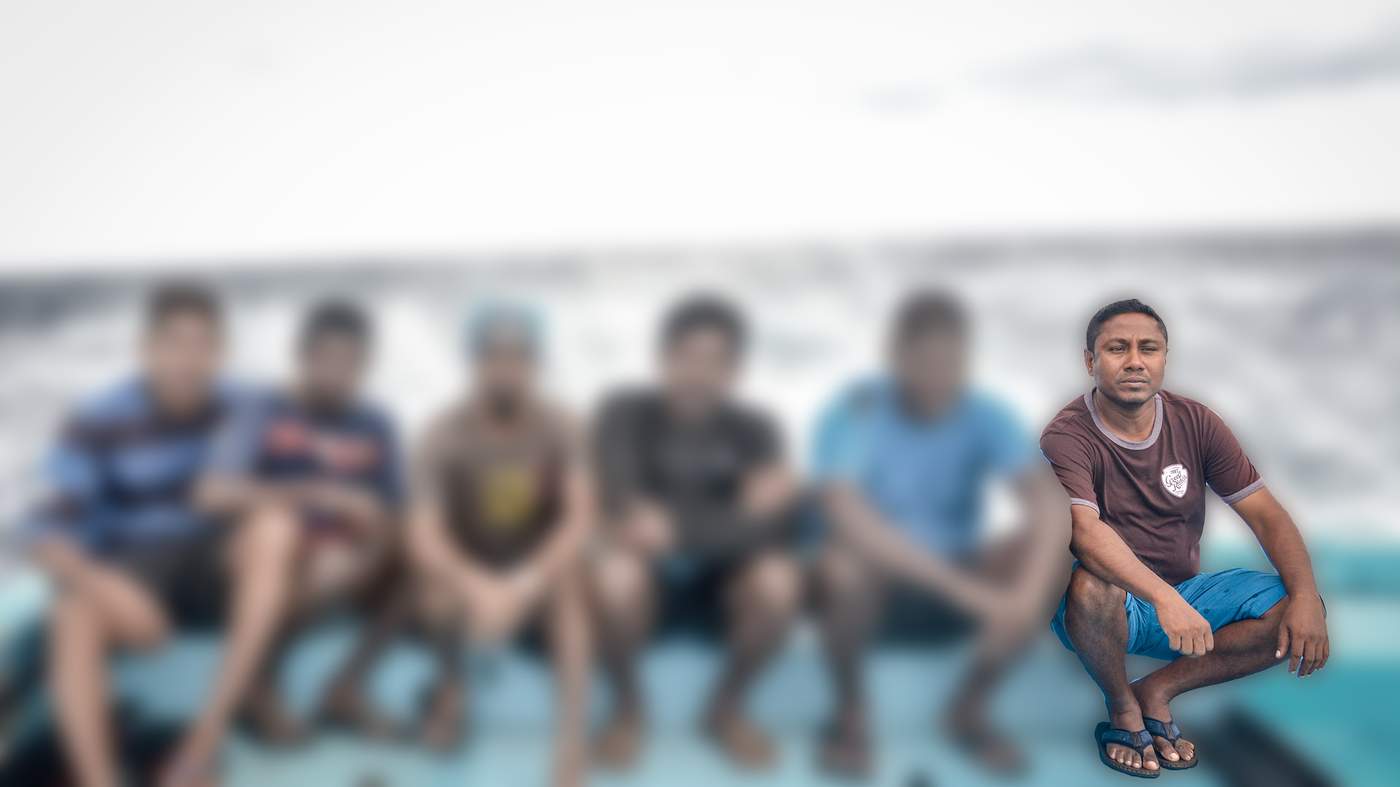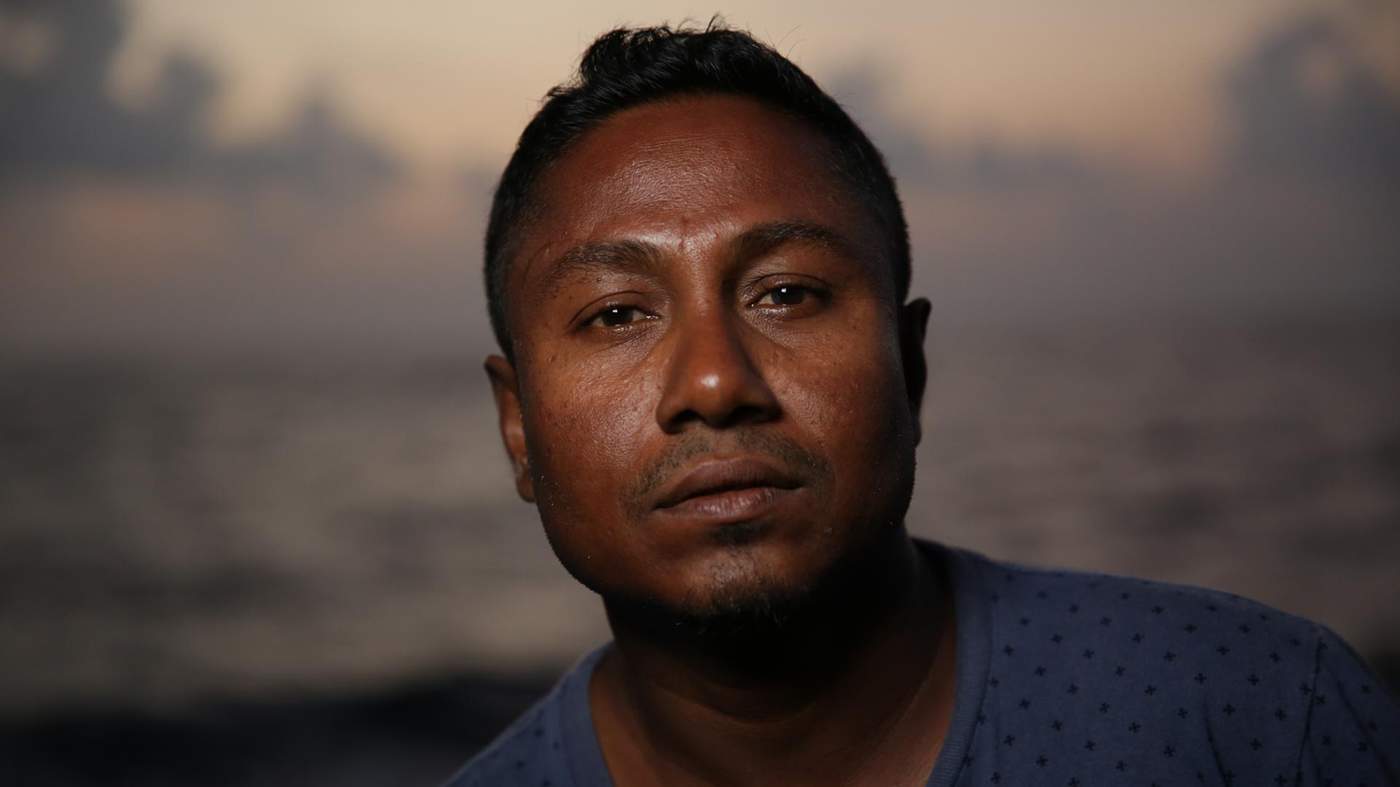Most of the world’s fishing vessels may use sound to find their prey, but traditional tuna fishers in the Maldives still favour sight. Sophisticated sonar equipment is less crucial than a good pair of binoculars. Looking out is favoured over listening down.
So it is not a beep on a screen that alerts the crew of the Kan'du Roalhi to a school of skipjack tuna, but specks of grey-black on a distant horizon.
As they approach, the specks take form: seabirds, wheeling and circling over head. The size of the flock is a sure sign that the school underneath will be a large one.
The boat slows as flashes of silver cut through the calm surface of the ocean. The crew leap into action, turning on water sprays and scattering handfuls of small fish – known as baitfish – into the sea. This creates the illusion of a large school of fish near the surface, sending the tuna into such a feeding frenzy that they will bite at any shiny, moving object in the water.
As the simmering ocean starts to boil with life, barbless hooks attached to long wooden poles are lowered into the fray. When the tuna bite, the fishermen, standing shoulder-to-shoulder at the stern of the boat, heave them one-by-one overhead and onto the deck behind
Pole and line fishing
This is pole-and-line fishing. A centuries-old technique for catching tuna, thought to have originated in the Maldives.
Because the fish are taken one-at-a-time with specialised equipment, there is very little bycatch of other species. And only a small proportion of a school is caught, minimising overall pressure on the stock.
A vital link
Not everyone aboard the Kan'du Roalhi is a fisherman. Ibrahim Nadheeh hasn’t caught a single tuna. Instead, he works behind the scenes to collect vital information on the fishery, including the size and number of the tuna caught, the different species used as baitfish, and the fuel efficiency of the vessel. A core staff member for the International Pole & Line Foundation (IPNLF), the data he collects inform management measures and best practice, ensuring a sustainable future for pole-and-line caught tuna.
A veteran fisheries officer with more than 100 monitoring trips under his belt, Ibrahim spends around a third of his time at sea. A typical shift begins at 10pm with a night-time expedition to look for baitfish and ends around 2pm the next day, when the boat returns to shore to offload its catch of tuna.
As a bridge between the fishermen and the Ministry of Fisheries, a close working relationship with the crew is vital.
The world champions of pole-and-line
There are a lot of tuna fishers in the Maldives. After tourism, it’s the most important industry. Roughly a third of the population are involved in fishing in some way – a figure that rises to 70% on isolated atolls. In a country that is 99% ocean, there is little land to cultivate and no space for livestock. This means that tuna is one of the only sources of protein in town, and is typically eaten with every meal.
All the tuna in the Maldives is caught using traditional, low-impact methods like pole-and-line. And because foreign vessels are banned from fishing in Maldivian waters, local communities get to keep most of the economic benefits.
All of which is making fishing a very desirable career choice in the Maldives.
Historically, Ibrahim explains, fishing was regarded a low-status, low-income profession. “Now it’s really changed. Everyone knows that fishermen are very well to do,” he says. “They have it much better than many other jobs. They work flexibly and independently, and they earn a very good income”.
While the catch method may be traditional, the boats themselves are anything but. Many boast air conditioning throughout, as well as TVs, entertainment systems and washing machines. Competition is fierce for places on board.
Safeguarding skipjack through certification
Given such a deep commitment to sustainability, it is not surprising that the Maldives skipjack fishery was an early advocate of ecolabelling, receiving MSC certification in 2012.
Today, much of the certified catch ends up on the shelves of responsible retailers like Woolworths, Albert Heijn, Carrefour, Waitrose and Sainsbury’s, and increasingly, in the sandwiches they sell.
The fishers like having the recognition of MSC certification. By changing the way that the world looks at the fishery, Ibrahim says, certification has inspired them to take even better care of the tuna they land. As a result, they’ve introduced practices that minimise handling and maximise quality.
And these aren’t the only improvements that the industry has made. In 2016, the Indian Ocean Tuna Commission, the body responsible for managing tuna in the region, agreed to adopt harvest control rules for skipjack. A vital tool in modern fisheries management, the rules act as an insurance policy by defining a point at which fishing must reduce to prevent a stock becoming overfished.
For Martin Purves, Managing Director of the IPNLF, a not-for-profit that works to develop, support and promote pole-and-line fisheries, the adoption of rules was a ground-breaking moment in the responsible management of tuna fisheries globally.
“It is the first ever precautionary harvest control rule adopted [for tuna] while stocks are not overfished and reaffirms the sustainability credentials of the MSC certified Maldives pole-and-line fishery”
Ibrahim agrees. Things are moving in the best possible direction, he says.
But that’s not the say that industry isn’t facing challenges. With 80% of the country lying less than a metre above sea level, the Maldives are particularly vulnerable to the effects of climate change. And because the tuna migrate over huge distances, stocks in Maldivian waters can be adversely affected by overexploitation elsewhere.
But Ibrahim remains optimistic. For him, this generation is most environmentally responsible yet. The fishery has passed through the generations for hundreds of years, and he is confident that its innovative blend of traditional techniques and modern management means that it will continue long into the future.
See more from Ibrahim and his colleagues in this short film from Woolworths, South Africa.
Images and video copyright Woolworths South Africa
Share this story:
Sign up to our newsletters:

